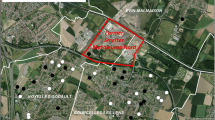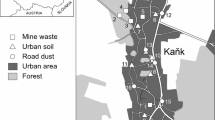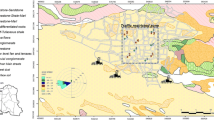Abstract
The elemental composition and bioaccessibility of trace metals have been determined in a variety of geosolids (soils, road dusts and house dusts) from an arid, coastal region (Dhahran, Saudi Arabia). Concentrations of many elements reflected those of the local geology, ascertained by analysis of desert sand. Several trace metals (e.g. Cu, Sb, Zn, Pb, Tl and Sn) were moderately enriched in both road and house dusts, reflecting external and internal (household) anthropogenic sources. For a given trace metal, bioaccessibilities, assessed using a physiologically based extraction test, were broadly similar across the range of geosolids. Median values for a simulated gastric phase ranged from less than 10% (Ba, Cu, Cr, Ni and V) to more than 50% (As, Cd, Sb, Sn and Tl), and for a subsequently simulated intestinal phase from less than 15% (Ba, Cr, Cu, Ni, V and Zn) to more than 50% (As, Cd, Sb, Tl and U). Results suggest that the levels and bioaccessibilities of trace metals in dusts from arid environments are controlled by the dilution of anthropogenic particulates by variable (but significant) proportions of fine, baseline sand.


Similar content being viewed by others
References
Ahmad, Z., Allam, I. M., & Aleem, B. J. A. (2000). Effect of environmental factors on the atmospheric corrosion of mild steel in aggressive sea coastal environment. Anti-Corrosion Methods and Materials, 47, 215–225.
Akhter, M. S., & Madany, I. M. (1993). Heavy metals in street and house dust in Bahrain. Water, Air and Soil Pollution, 66, 111–119.
Al-Rajhi, M. A., Seaward, M. R. D., & Al-Aamer, A. S. (1996). Metal levels in indoor and outdoor dust in Riyadh, Saudi Arabia. Environmental International, 22, 315–324.
Al-Shayea, N. A. (2000). Inherent heterogeneity of sediments in Dhahran, Saudi Arabia—a case study. Engineering Geology, 56, 305–323.
Al-Shayeb, S. M. (2003). Metals content of roadside soils in Riyadh (Saudi Arabia), with particular reference to traffic density. Asian Journal of Chemistry, 15, 1229–1245.
Cave, M. R., Wragg, J., Palumbo, B., Klinck, B. A. (2000). Measurement of the bioaccessibility of arsenic in UK soils. British Geological Survey and Environment Agency R&D Technical Report P5-062/TR02. Environment Agency, Bristol, UK.
Chattopadhyay, G., Lin, K. C. P., & Feitz, A. J. (2003). Household dust metal levels in the Sydney metropolitan area. Environmental Research, 93, 301–307.
Culbard, E. B., Thornton, I., Watt, J., Wheatley, M., Moorcroft, S., & Thompson, M. (1988). Metal contamination in British urban dusts and soils. Journal of Environmental Quality, 17, 226–234.
Fergusson, J. E., & Kim, N. D. (1991). Trace elements in street and house dusts: Sources and speciation. Science of the Total Environment, 100, 125–150.
Hooker, P. J., & Nathanail, C. P. (2006). Risk-based characterization of lead in urban soils. Chemical Geology, 226, 340–351.
Krauskopf, K. B., & Bird, D. K. (1995). Introduction to geochemistry (p. 647). New York: McGraw-Hill.
Lisiewicz, M., Heimburger, R., & Golimowski, J. (2000). Granulometry and the content of toxic and potentially toxic elements in vacuum-cleaner collected, indoor dusts of the city of Warsaw. Science of the Total Environment, 263, 69–78.
Morawska, L., & Salthammer, T. (eds). (2004). Indoor environment: Airborne particles and settled dust (p. 450). Weinheim: Wiley-VCH.
Oliver, D. P., McLaughlin, M. J., Naidu, R., Smith, L. H., Maynard, E. J., & Calder, I. C. (1999). Measuring Pb bioavailability from household dusts using an in vitro model. Environmental Science and Technology, 33, 4434–4439.
Rasmussen, P. E., Subramanian, K. S., & Jessiman, B. J. (2001). A multi-element profile of house dust in relation to exterior dust and soils in the city of Ottawa, Canada. Science of the Total Environment, 267, 125–140.
Rieuwerts, J. S., Searle, P., & Buck, R. (2006). Bioaccessible arsenic in the home environment in southwest England. Science of the Total Environment, 371, 89–98.
Ruby, M. V., Davis, A., Schoof, R., Eberle, S., & Sellstone, C. M. (1996). Estimation of lead and arsenic bioavailability using a physiologically based extraction test. Environmental Science and Technology, 30, 422–430.
Ruby, M. V., Schoof, R., Brattin, W., Goldade, M., Post, G., Harnois, M., et al. (1999). Advances in evaluating the oral bioavailability of inorganics in soil for use in human health risk assessment. Environmental Science and Technology, 33, 3697–3705.
Sadiq, M., & Mian, A. A. (1994a). Nickel and vanadium in air particulates at Dhahran (Saudi Arabia) during and after the Kuwait oil fires. Atmospheric Environment, 28, 2249–2253.
Sadiq, M., & Mian, A. A. (1994b). Lead, titanium and zinc in air particulates at Dhahran, Saudi Arabia, during and after Kuwait oil fires. Science of the Total Environment, 152, 113–118.
Smith, B., Rawlins, B. G., Cordeiro, M. J. A. R., Hutchins, M. G., Tiberindwa, J. V., Sserunjogi, L., & Tomkins, A. M. (2000). The bioaccessibility of essential and potentially toxic trace elements in tropical soils from Mukono District, Uganda. Journal of the Geological Society, London, 157, 885–891.
Stewart, M. A., Jardine, P. M., Barnett, M. O., Mehlhorn, T. L., Hyder, L. K., & McKay, L. D. (2003). Influence of soil geochemical and physical properties on the sorption and bioaccessibility of chromium(III). Journal of Environmental Quality, 32, 129–137.
Tang, X.-Y., Cui, Y.-S., Duan, J., & Tang, L. (2008). Pilot study of temporal variations in lead bioaccessibility and chemical fractionation in some Chinese soils. Journal of Hazardous Materials, 160, 29–36.
Tong, S. T. Y., & Lam, K. C. (2000). Home sweet home? A case study of household dust contamination in Hong Kong. Science of the Total Environment, 256, 115–123.
Turner, A., & Simmonds, L. (2006). Elemental concentrations and metal bioaccessibility in UK household dust. Science of the Total Environment, 371, 74–81.
Turner, A., & Ip, K. H. (2007). Bioaccessibility of metals in dust from the indoor environment: application of a physiologically based extraction test. Environmental Science and Technology, 41, 7851–7856.
Turner, A., & Price, S. (2008). Bioaccessibility of platinum group elements in automotive catalytic converter particulates. Environmental Science and Technology, 42, 9443–9448.
Turner, A., Singh, N., & Richards, J. P. (2009). Bioaccessibility of metals in soils and dusts contaminated by marine antifouling paint particles. Environmental Pollution, 157, 1526–1532.
von Lindern, I., Spalinger, S., Petroysan, V., & von Braun, M. (2003). Assessing remedial effectiveness through the blood lead:soil/dust lead relationship at the Bunker Hill Superfund site in the Silver Valley of Idaho. Science of the Total Environment, 303, 139–170.
World Health Organisation (2000). Guidelines for air quality. WHO Report SDE/OEH/00.02, Geneva, p. 104.
Yu, C. H., Yiin, L. M., & Lioy, P. J. (2006). The bioaccessibility of lead (Pb) from vacuumed house dust on carpets in urban residences. Risk Analysis, 26, 125–134.
Acknowledgements
We thank Andy Arnold and Andy Fisher (UoP) for technical assistance throughout the study.
Author information
Authors and Affiliations
Corresponding author
Rights and permissions
About this article
Cite this article
Turner, A., Hefzi, B. Levels and Bioaccessibilities of Metals in Dusts from an Arid Environment. Water Air Soil Pollut 210, 483–491 (2010). https://doi.org/10.1007/s11270-009-0274-7
Received:
Accepted:
Published:
Issue Date:
DOI: https://doi.org/10.1007/s11270-009-0274-7




